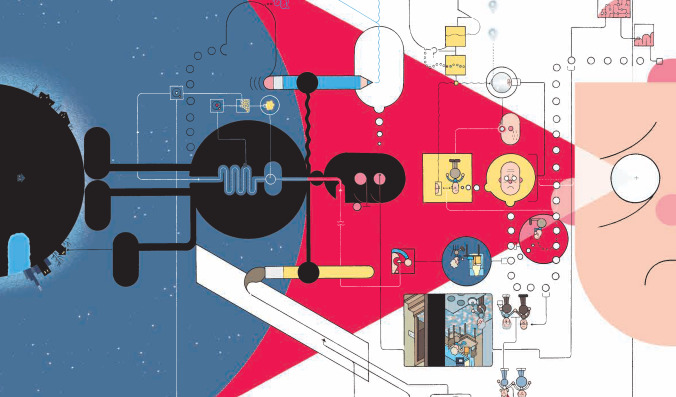Cartoonist Chris Ware has helped push the comic-book medium to new heights of mainstream popularity, and his passion for the art form is at the core of Monograph (Rizzoli), a huge art book tracing Ware’s personal and creative development from his early years growing up in Omaha through his experimental early adulthood to his present-day success. Approximately a foot wide and a foot-and-a-half tall, Monograph’s size reflects Ware’s heightened status in both the literary and art worlds. The fact that someone is publishing a book this big dedicated to the philosophy, technique, and evolution of a living cartoonist highlights how celebrated Ware is as both a storyteller and formal innovator, and the project is even more impressive because it’s so personal.
Monograph reveals an artist who has always been pushing himself, and that growth hasn’t slowed down over time. Readers can always expect Ware to go above and beyond with each new work: His last major release was the wildly ambitious Building Stories, a box containing 14 different books, tabloid sheets, and pamphlets that combined to form a sprawling, deeply immersive narrative. A creative endeavor like that requires a wide array of skills, and Monograph showcases the numerous artistic avenues Ware has explored and breaks down how they informed his cartooning.
Working with sculptures and dioramas helped him visualize spaces and characters in three dimensions, and playing around with animation—he built a zoetrope for himself because he figured he’d never be able to buy one—provided new insights regarding expression and two-dimensional movement. Ware also writes very evocative prose, and some of the best moments are when he goes off on a tangent to recount major and minor personal moments, and these art pieces of the past become gateways into his emotions.
Ware is also responsible for the production and design, and it’s rare to see an art book that blends a bold graphic sensibility with clever, expressive layouts. An especially fun production touch is the inclusion of stapled mini-comics (and one piece of sheet music) that are glued onto the page, and these small surprises create a more interactive reading experience. In the case of the sheet music, Ware tells a short story by including a picture of his grandmother during the trip that inspired the piano composition, and he makes the reader dig for that moment by putting it behind pages of music notes.
The most powerful visual moment in the book has a picture of one of Ware’s cartoon diary sketchbooks in the middle of the page, surrounded on all sides by shrunken entries covering multiple years. All that time condensed in a 100 or so pages, bound in one small, black package. The time period for these sketchbooks is “2002-death,” and the small detail that these sketchbooks end with his life adds a spiritual dimension to the page. Biographical elements seep into his work like any other artist, but these diaries are his private record of daily personal experiences over many years, making that black rectangle in the center of the page more than just a sketchbook. It’s a life. That simple geometric shape is imbued with meaning because of how it’s arranged on a page in relation to other sequential images, showing the depth of Ware’s brilliant ability to find concise ways of visually conveying complex ideas.









































